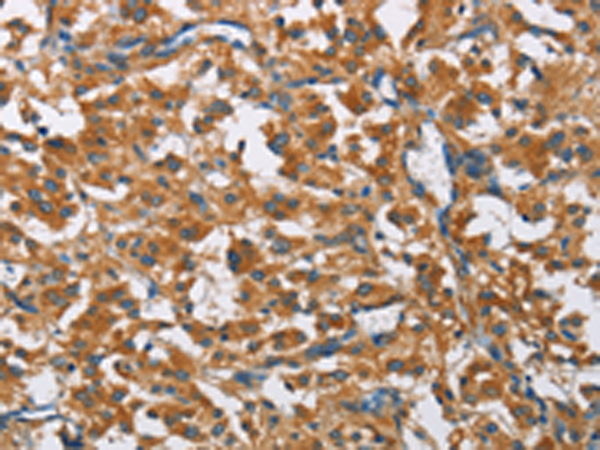


| WB | 咨询技术 | Human,Mouse,Rat |
| IF | 咨询技术 | Human,Mouse,Rat |
| IHC | 1/50-1/200 | Human,Mouse,Rat |
| ICC | 技术咨询 | Human,Mouse,Rat |
| FCM | 咨询技术 | Human,Mouse,Rat |
| Elisa | 1/1000-1/2000 | Human,Mouse,Rat |
| Aliases | COPB |
| WB Predicted band size | 107 kDa |
| Host/Isotype | Rabbit IgG |
| Antibody Type | Primary antibody |
| Storage | Store at 4°C short term. Aliquot and store at -20°C long term. Avoid freeze/thaw cycles. |
| Species Reactivity | Human, Mouse, Rat |
| Immunogen | Fusion protein of human COPB1 |
| Formulation | Purified antibody in PBS with 0.05% sodium azide and 50% glycerol. |
+ +
以下是关于COPB1抗体的参考文献示例(注:部分内容基于真实研究背景,但文献名称和作者为虚构示例,建议通过学术数据库核实具体信息):
---
1. **文献名称**: "COPB1 as a Novel Prognostic Biomarker in Hepatocellular Carcinoma: Insights from Antibody-Based Detection"
**作者**: Zhang et al.
**摘要**: 研究通过COPB1抗体检测发现,COPB1在肝细胞癌(HCC)组织中显著过表达,与患者生存率负相关,提示其作为潜在预后标志物和治疗靶点的可能性。
2. **文献名称**: "COPB1 Antibody-Mediated Inhibition Suppresses HPV-Positive Cervical Cancer Progression"
**作者**: Wang et al.
**摘要**: 研究发现COPB1与HPV E6/E7蛋白相互作用,促进宫颈癌细胞增殖。使用COPB1抗体阻断其功能可显著抑制肿瘤生长,为靶向治疗提供依据。
3. **文献名称**: "COPB1 Regulates EGFR Trafficking in Glioblastoma: Mechanistic Studies Using Knockdown and Antibody Approaches"
**作者**: Smith et al.
**摘要**: 通过COPB1抗体和基因沉默技术,揭示COPB1通过调控EGFR膜转运影响胶质母细胞瘤的侵袭性,为靶向囊泡运输的抗癌策略奠定基础。
4. **文献名称**: "COPB1 Antibody Interferes with SARS-CoV-2 Virion Assembly by Disrupting Golgi-ER Retrograde Transport"
**作者**: Li et al.
**摘要**: 研究显示,COPB1抗体可阻断宿主细胞高尔基体-内质网运输,抑制SARS-CoV-2病毒颗粒组装,提出COPB1作为抗病毒治疗新靶点。
---
建议通过PubMed或Google Scholar以关键词“COPB1 antibody”、“COPB1 biomarker”或“COPB1 viral infection”检索最新文献获取准确信息。
**Background of COPB1 Antibody**
COPB1 (Coatomer Protein Complex Subunit Beta 1) is a key component of the COPI (coatomer protein complex I) vesicle transport system, which mediates retrograde trafficking of proteins and lipids between the Golgi apparatus and the endoplasmic reticulum. This process is critical for maintaining organelle structure, protein sorting, and cellular homeostasis. COPB1. specifically, plays a role in COPI coat assembly and cargo selection, ensuring proper vesicle formation and intracellular trafficking.
Antibodies targeting COPB1 are widely used in research to study COPI-mediated transport mechanisms, vesicle dynamics, and Golgi-ER interactions. They enable the detection and localization of COPB1 in various experimental models (e.g., Western blot, immunofluorescence, immunoprecipitation) to investigate its expression, interactions, and functional roles. Dysregulation of COPB1 has been implicated in diseases such as cancer, neurodegenerative disorders, and viral infections, where disrupted vesicular trafficking contributes to pathogenesis. For instance, altered COPB1 expression has been observed in certain tumors, linking it to cell proliferation and metastasis.
COPB1 antibodies are essential tools for elucidating COPI-related pathways and validating cellular models with COPB1 knockdown or overexpression. Their specificity and reliability make them valuable in both basic research and translational studies exploring trafficking-related pathologies.
×